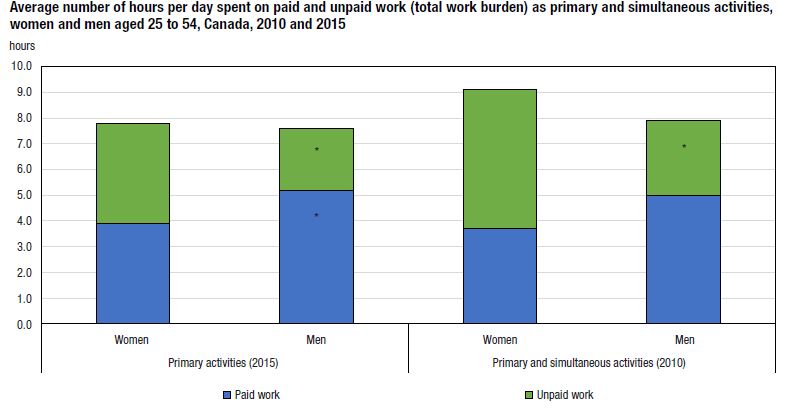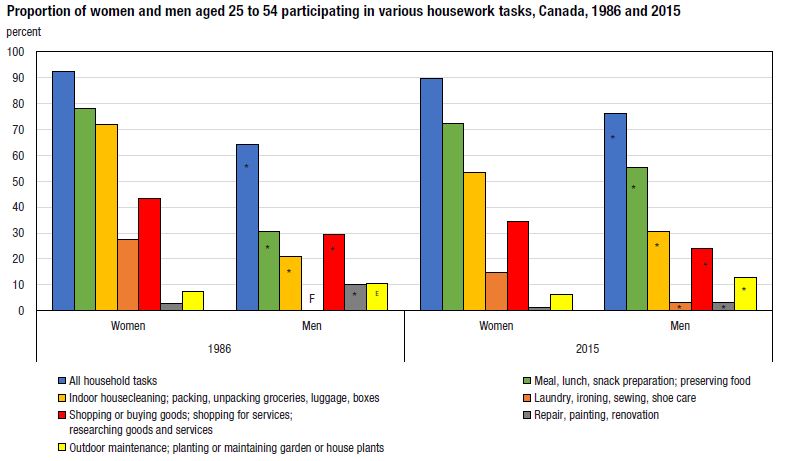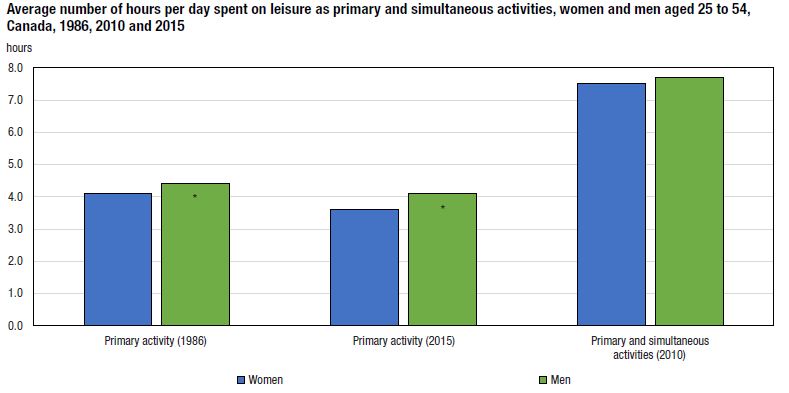The Economics and Statistics Division maintains archives of previous publications for accountability purposes, but makes no updates to keep these documents current with the latest data revisions from Statistics Canada. As a result, information in older documents may not be accurate. Please exercise caution when referring to older documents. For the latest information and historical data, please contact the individual listed to the right.
<--- Return to Archive
For additional information relating to this article, please contact:
August 07, 2018TIME USE: TOTAL WORK BURDEN, UNPAID WORK, AND LESIURE A recent study by Statistics Canada: Time use: total work burden, unpaid work and leisure examined how men and women spend their time differently and how time use patterns have changed over the past 30 years. The study uses data from the General Social Survey on Time Use (1986, 2010, 2015) and covers individuals aged 25 to 54 living in the 10 provinces excluding institutionalized populations and First Nations reserves. The Time Use survey is a retrospective 24-hour time diary to collect information about participation and time spent on day-to-day activities. Time use data on activities that are performed simultaneous with other activities is only available from the 2010 survey. Asterisks (*) in all charts are from the report and indicate that there was a statistically significant difference between men and women at the 5 per cent level for that category.
The total work burden is the sum of time spent on paid and unpaid work and was equivalent in 2015 between women and men. Women tend to spend more time on unpaid work, spending 3.9 hours per day on unpaid work as a primary activity compared to 2.4 hours for men, while men spent an average of 5.2 hours on paid employment compared to the women average of 3.9 hours per day. However, when unpaid work performed as a simultaneous activity is included, women's total work burden was 1.2 hours greater per day at 9.1 hours compared to 7.9 hours among men.

Source: Statistics Canada, Time use: Total work burden, unpaid work and leisure
Participation in various types of household tasks have changed since 1986, but continue to differ between men and women in 2015. Women in Canada are more likely than men to participate in meal and snack preparation, indoor house cleaning, and laundry while less likely to participate in outdoor maintenance, and repair, painting and renovation. In addition to being more likely to participate, women spend more time on housework as a primary activity. Among those that participated in housework, women spent an average of 3.1 hours compared to 2.5 hours for men in 2015. Compared to 1986, the participation in housework by men has increased from 64.3 per cent to 76.2 per cent and is responsible for the greater housework activity by men as the average time spent was essentially unchanged. Combining the participation and average time spend on house work, women's time spend on housework has decreased by an average of 42 minutes to 2.8 hours per day and the time men spent on housework has increased by 24 minutes to 1.9 hours per day over the past 30 years.

Source: Statistics Canada, Time use: Total work burden, unpaid work and leisure
Time spent on housework also exhibit different patterns based on employment status, family type, education, and income. For instances, women spend more time on housework activities if they are not employed or part-time employed while men housework time is little changed across employment status categories. Housework time use was higher for couple families, particularly with children under the age of 18, and lone-parent families. The amount of time women spend on housework decreases with greater personal income; women in the top 25% of the income distribution spent an average of 2.5 hours per day compared to 3.5 hours per day by women in the bottom quartile.

Source: Statistics Canada, Time use: Total work burden, unpaid work and leisure
Both mothers and fathers spend more time on child care than 30 years ago. Among those that participate, women's time spent on child care increased 36 minutes per day to 2.6 hours while among men it increased 24 minutes to 2.0 hours per day. In 2015, women were more likely to participate in caring for children at 37.4% compared to 25.3% of men. The gender gap in time spent on child care was stable at 30 minutes between 1986 and 2015, but the gap widens to one hour when considering average hours of both primary and simultaneous activities. Women were more likely than men to participate in caregiving to an adult family member or friend on any given day.

Source: Statistics Canada, Time use: Total work burden, unpaid work and leisure
Both sexes spent less time on leisure activities than 30 years ago. Women spent an average of 3.6 hours per day on leisure activities in 2015 compared to 4.1 hours by men. Women were more likely to participate in reading or listening to music/radio, socializing, writing, arts and hobbies while men were more likely to participate in active sports and the use of technology. Women were more likely than men to simultaneously do unpaid work or be in the company of children during leisure time, with 20 per cent doing so compared to 6.0 per cent of men.

Source: Statistics Canada, Time use: Total work burden, unpaid work and leisure
Source: Time use: Total work burden, unpaid work, and leisure
Definitions:
Housework includes all unpaid household activities, excluding caregiving: meal, lunch or snack preparation; preserving food, including baking, freezing, sealing or packing foods; indoor house cleaning, dish washing or tidying; taking out the garbage, recycling, compost or unpacking goods; laundry, ironing, folding, sewing or shoe care; repair, painting or renovation; organizing, planning or paying bills; unpacking groceries, packing and unpacking luggage for travel and/or boxes for a move; outdoor maintenance, including car repair, ground maintenance, snow removal or cutting grass; planting (picking), maintaining, cleaning garden or caring for house plants; pet care, including feeding, walking, grooming or playing; shopping for or buying goods; shopping for services; and researching goods or services.
Routine child care tasks include food preparation and feeding; getting children ready for school; putting children to bed; personal and emotional care for children; medical care for children; visiting childcare/school establishments; communication related to childcare/school; other educational and non-educational help for children; and travel to and from care for children. Tasks related to child engagement, development, and education include helping, teaching, and reprimanding; reading with children; talking/conversation with children; and playing with children.
Leisure activities include socializing or communicating; exercising; participating in organized recreational, competitive, or outdoor sports; participating in outdoor activities; attending cinema, exhibitions, library, concerts, theatre, entertainment events; attending sports events; visiting museums, art galleries, heritage sites, zoos, observatories; drawing, painting, or crafting; walking; taking a leisurely drive; birdwatching; reading; writing; using some form of technology; reading; watching television or videos; or listening to music or radio.
<--- Return to Archive